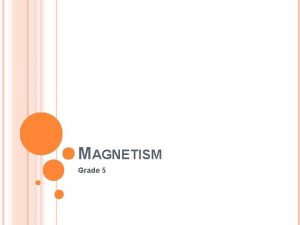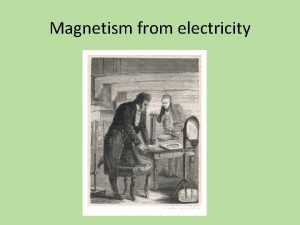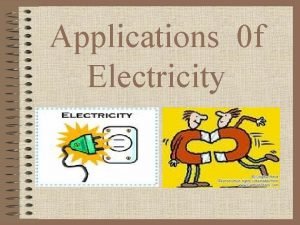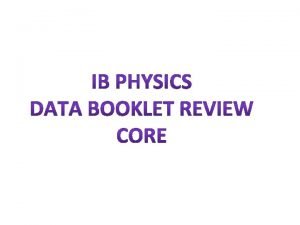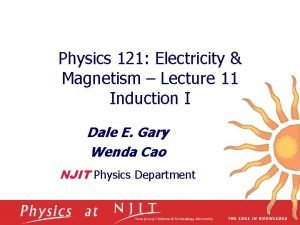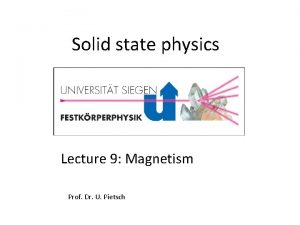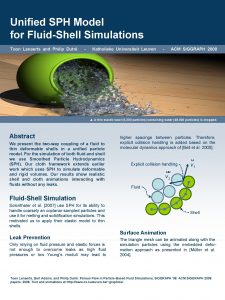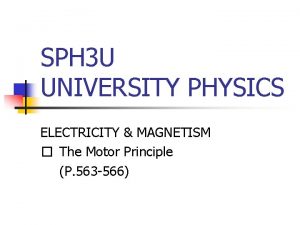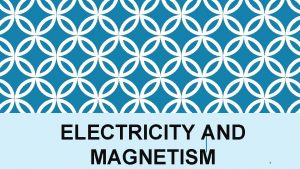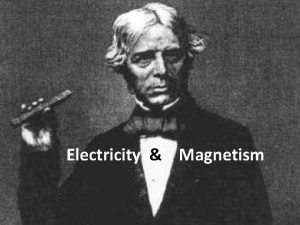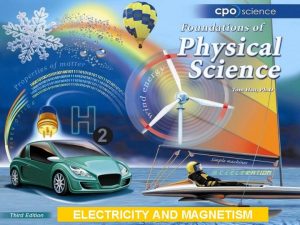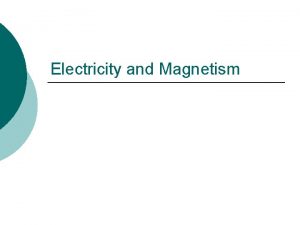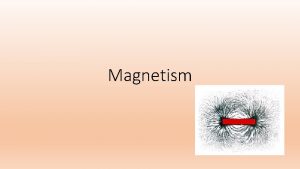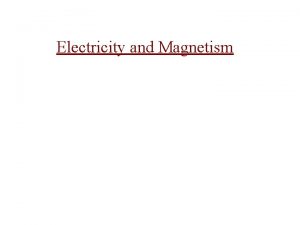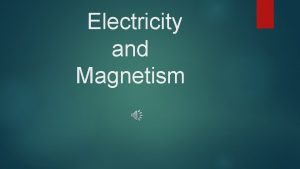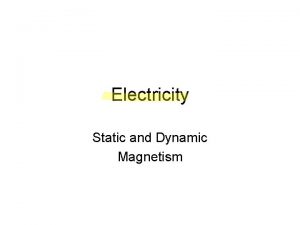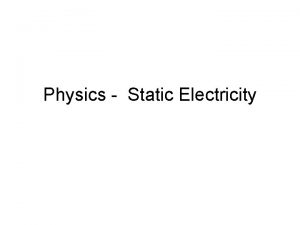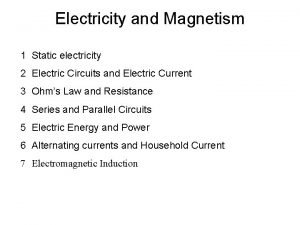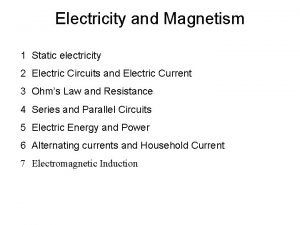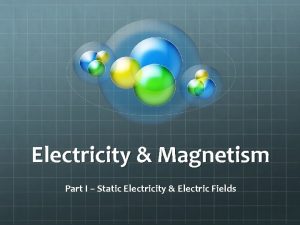SPH 3 U UNIVERSITY PHYSICS ELECTRICITY MAGNETISM Electric




















- Slides: 20

SPH 3 U UNIVERSITY PHYSICS ELECTRICITY & MAGNETISM � Electric Current (P. 516 -441)

What Is Electricity? Electricity is something we generally take for granted. It is something we cannot see, hear, or touch. Electricity is also difficult to describe. In physics, the word “electricity” refers to electrical energy and the movement of charge. This movement of charge is known as electric current (I) and is measured in amperes (A). ELECTRIC CURRENT (I) v movement of charge v SI unit is amperes (A) December 12, 2021 3 U 4 - Electric Current 1

The Direction of Electric Current In the mid 1700 s Benjamin Franklin, a wellknown American scientist, flew a kite during a lighting storm to investigate the nature of electricity. He decided that when describing electricity, an excess of electricity (or the charge that makes up the electricity) is positive and a deficit of electricity is negative. In other words, the charge moves from the positive terminal to the negative terminal of the source of electric potential. December 12, 2021 3 U 4 - Electric Current 2

The Direction of Electric Current NOTE! The lightning did not strike the kite directly; that would have immediately destroyed the kite and seriously injured, or killed, him. December 12, 2021 3 U 4 - Electric Current 3

The Direction of Electric Current This assumption about the direction of the electric current was called conventional current or just electric current. CONVENTIONAL CURRENT v or electric current v charge moves from the “+” terminal through the circuit to the “–” terminal December 12, 2021 3 U 4 - Electric Current 4

The Direction of Electric Current NOTE! This convention of describing electricity became entrenched in science, but ~ 150 years later the electron was discovered. It soon became clear that what actually constituted an electric current in a metallic conductor (such as a wire) was a flow of negatively charged electrons from the negative terminal to the positive terminal of the source of electric potential. December 12, 2021 3 U 4 - Electric Current 5

The Direction of Electric Current This method of describing the direction of electric current is referred to as electron flow. ELECTRON FLOW v negatively charged electrons move from the “–” terminal through the circuit to the “+” terminal December 12, 2021 3 U 4 - Electric Current 6

The Direction of Electric Current NOTE! It might help to realize that a positive charge flowing east along a wire is electrically equivalent, in every way, to a negative charge flowing west. December 12, 2021 3 U 4 - Electric Current 7

Electric Current Electric current comes in two forms: direct current and alternating current. In direct current (DC), the current flows in one direction only and doesn’t increase or decrease in magnitude. Direct current is produced by an electric cell, such as a battery, to power portable electrical devices. December 12, 2021 3 U 4 - Electric Current 8

Electric Current DIRECT CURRENT (DC) v current flows in one direction only v batteries, solar cells, . . . December 12, 2021 3 U 4 - Electric Current 9

Electric Current In alternating current (AC), the current moves back and forth, alternating direction. Alternating current is produced by generators at electric generating stations. Alternating current is used because it is a more efficient method of distributing electrical energy over long distances. Wall outlets provide alternating current. December 12, 2021 3 U 4 - Electric Current 10

Electric Current ALTERNATING CURRENT (AC) v current moves back and forth (i. e. alternates direction) v more efficient method of distributing electrical energy over long distances v wall outlets, generators, . . . December 12, 2021 3 U 4 - Electric Current 11

Electric Current NOTE! Some people visualize electric current as an actual continuous flow of charges that start at the energy source, travel through wires to the load, and then return to the source. Electric current does not happen that way. The electrons throughout the wires are ready to move as soon as the switch is turned on, just like water is ready to flow before a tap is turned on. To produce a current, all the electrons need is a push (the electric force) from the source, which occurs as soon as the circuit is closed. As a result of the push, the electrons that are in the load give up energy. December 12, 2021 3 U 4 - Electric Current 12

Electric Current An ammeter is a device that measures the amount of electric current in a circuit. It is connected directly into the path of the moving charges, as shown. This type of connection is called a series connection. December 12, 2021 3 U 4 - Electric Current 13

Electric Current AMMETER ( ) v used to measure the current in a circuit v connected in series with load December 12, 2021 3 U 4 - Electric Current 14

Electric Current PRACTICE 1. A student connected an ammeter as shown. Did the student connect the ammeter correctly? Explain. December 12, 2021 3 U 4 - Electric Current 15

Electric Current – DYK? The nerve cells in your body communicate with each other by creating very small electric currents. If a larger current is transmitted through your body it can overload your nervous system. By touching a wire with a current flowing through it, you can affect the current in your body. Muscles will contract and you may not be able to let go of the wire. The electric current will also cause burns, because some of the electrical energy will be transformed into thermal energy. December 12, 2021 3 U 4 - Electric Current 16

Electric Current – DYK? NOTE! A current of 0. 016 A is sometimes referred to as the “let-go threshold, ” because if the current is above this value, the person cannot let go of the object giving the electric shock. December 12, 2021 3 U 4 - Electric Current 17

�Check Your Learning 1. Convert the following measurements as indicated, assuming two significant digits: 0. 65 A (a) 650 m. A = _____ 0. 085 A (b) 85 m. A = _____ 4. 5 A (c) 4500 m. A = _____ 95 (d) 0. 095 A = _____ m. A December 12, 2021 3 U 4 - Electric Current 18

�Check Your Learning TEXTBOOK P. 515 Q. 2, 3, 5 (PJ: Benjamin Franklin) December 12, 2021 3 U 4 - Electric Current 19
 4 forces of nature
4 forces of nature Ib physics chapter 5
Ib physics chapter 5 Electricity and magnetism lecture notes
Electricity and magnetism lecture notes Electricity and magnetism jeopardy
Electricity and magnetism jeopardy Sph3u electricity and magnetism
Sph3u electricity and magnetism Electromagnet experiment hypothesis
Electromagnet experiment hypothesis Magnetism and electricity
Magnetism and electricity Electricity and magnetism grade 5
Electricity and magnetism grade 5 Electricity and magnetism
Electricity and magnetism Electricity and magnetism
Electricity and magnetism Ampere
Ampere Electricity and magnetism
Electricity and magnetism Electricity and magnetism
Electricity and magnetism Magnetism vocabulary
Magnetism vocabulary Static electricity and current electricity
Static electricity and current electricity Current electricity
Current electricity Magnetism
Magnetism Conceptual physics magnetism
Conceptual physics magnetism University physics with modern physics fifteenth edition
University physics with modern physics fifteenth edition Sph toon
Sph toon Netgear sph
Netgear sph







